10 fascinating things you probably didn't know about Stuttgart
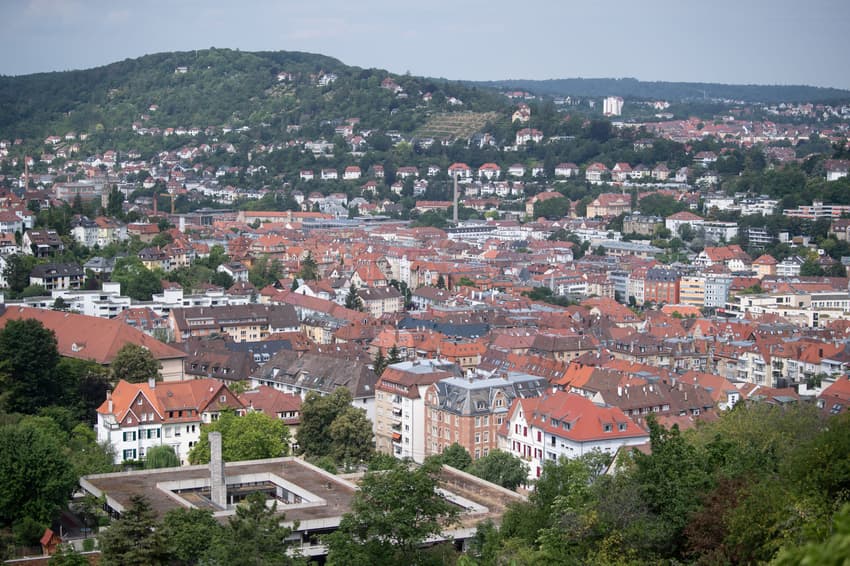
Stuttgart is the capital city of Baden-Württemberg and the sixth largest city in Germany. But here are 10 facts you may not already know about the city, even if you live there.
1. The city's Fernsehturm was the first of its kind in history
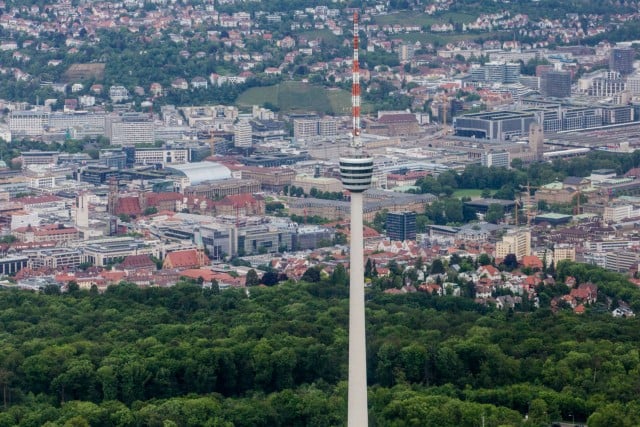 Stuttgart Fernsehturm. Photo: DPA
Stuttgart Fernsehturm. Photo: DPA
Stuttgart's Fernsehturm, meaning television tower, was the first concrete television tower in the world. Renowned structural engineer and bridge builder Professor Fritz Leonhardt was the mastermind behind the building.
Rather than simply creating a functional metal TV mast, he had the idea to use the tower as a tourist attraction with a restaurant and viewing platform. The tower is 217m tall but stands on a hill making it 283m above sea level in total. It is visible from all over the city and has influenced the design of other television towers around the world.
READ ALSO: Seven maps that explain Baden-Württemberg
2. Stuttgart is the home of the petrol-powered car
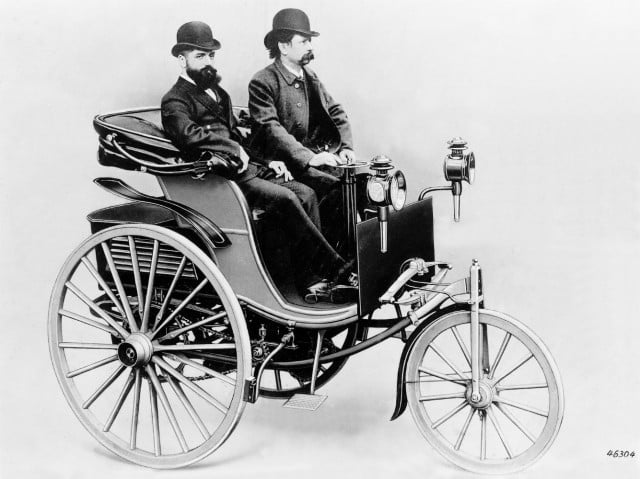 Carl Benz's patented motorvehicle 1885. Photo: DPA
Carl Benz's patented motorvehicle 1885. Photo: DPA
Stuttgart is credited as the birthplace of the petrol powered motorcar with an impressive history in the field of car manufacturing. Pioneering engineers Gottlieb Daimler and Carl Benz were both born near Stuttgart and their 125-year legacy is celebrated at the Mercedes-Benz Welt museum in the east of the city.
Benz is credited with creating the first 3-wheeled, purpose-built motorcar which was up and running in 1886 and 'Benzin', the German word for petrol, is consequently named after him.
Around a similar time, Daimler was working independently on creating a petrol engine which he used to power a modified horse-carriage in 1886. This was the first 4-wheeled motor vehicle in history.
Although the two men never actually met, their companies, Benz & Cie. and Daimler-Motoren-Gesellschaft (DMG), joined forces to create Daimler-Benz AG in the 1920s. From this evolved the brand name Mercedes-Benz and vehicles with the Mercedes and Daimler brand name are still manufactured in the city today.
3. The city gets its name from its horse breeding past
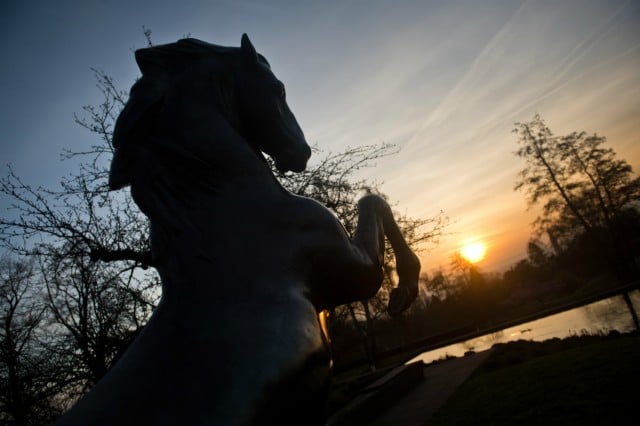 "Steigendes Pferd" (1939), a statue by Fritz von Graevenitz, in the Höhenpark Killesberg in Stuttgart. Photo: DPA
"Steigendes Pferd" (1939), a statue by Fritz von Graevenitz, in the Höhenpark Killesberg in Stuttgart. Photo: DPA
The area around which the city developed was originally a site for breeding cavalry horses, owned by Duke Liudolf von Schwaben in the 10th century. The name comes from 'Stutengarten' which is an archaic form of the German word 'Gestüt', meaning stud yard.
.jpg) Stuttgart coat of arms. Photo: Wikipedia. Porsche badge. Photo: Pixabay.
Stuttgart coat of arms. Photo: Wikipedia. Porsche badge. Photo: Pixabay.
The city coat of arms is consequently a black stallion which is recognizable to people around the world as it is featured on the Porsche logo, a make of cars which also originates from the Stuttgart area.
4. It is the only German city with a municipal wine estate
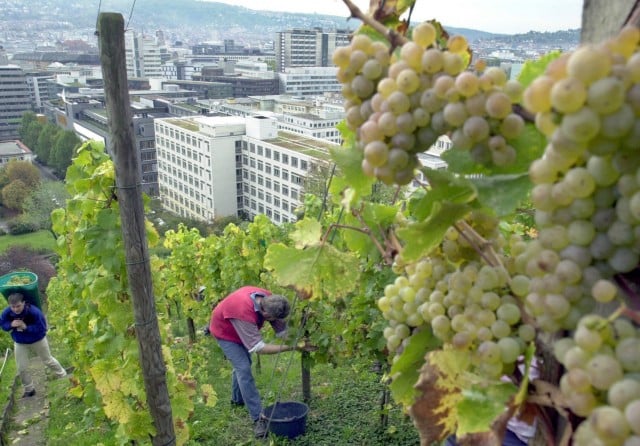 The vineyard of the IHK Stuttgart. Photo: DPA
The vineyard of the IHK Stuttgart. Photo: DPA
The presence of the wine industry in Stuttgart is hard to miss, with vineyards throughout the very heart of the city. Surprisingly, one of these vineyards is owned by a governmental department.
The Industrie- und Handelskammer Stuttgart (IHK), meaning Chamber of Industry and Commerce, came into possession of a vineyard and villa just before the outbreak of the Second World War. The plan was to use the plot of land to build a new IHK house with space for administration, events and the Stuttgart stock and securities exchange.
These plans were never fully realised due to the turmoil of the war; much of the land remained a vineyard which is still owned by the IHK to this day.
The Romans originally brought grape vines from the Tyrol region to Stuttgart in 3AD and grapes continue to thrive around the city creating popular wines such as Riesling and Trollinger.
5. Stuttgart is a city of stairs
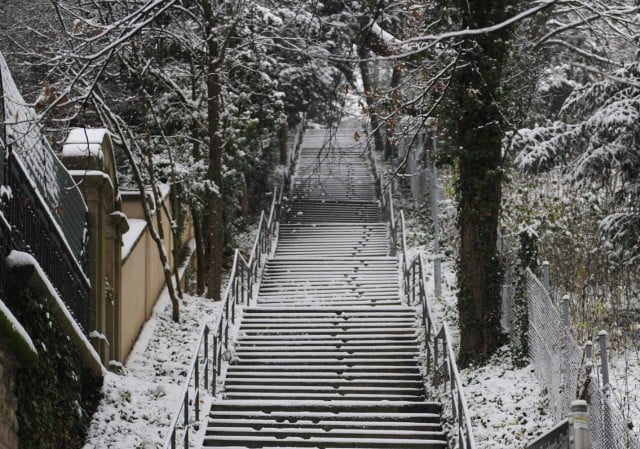 Stairway in the city centre. Photo: DPA
Stairway in the city centre. Photo: DPA
The capital of Baden-Württemberg is built upon a large number of hills, but with this comes the potentially more enjoyable side effect of a large number of vineyards.
To help people get up and down these hills each day, Stuttgart has over 400 sets of outdoor stairs in total. If you climbed them all, you would climb about 20 kilometres in total.
6. It's the number one city for culture in Germany, according to one study
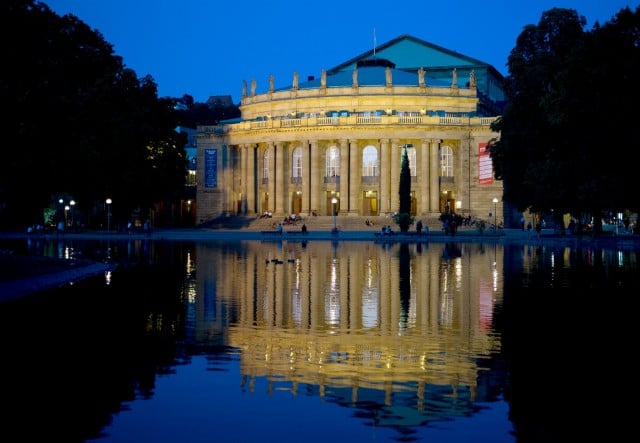 Stuttgart opera house. Photo: DPA
Stuttgart opera house. Photo: DPA
Stuttgart was ranked as the best city for culture in the country in a study by the Berenberg Bank and the Hamburgischen Weltwirtschaftsinstituts (HWWI) back in 2016.
In the city, 7.6 percent of people eligible to pay social insurance are employed in the culture sector - the highest proportion in Germany.
The number of people who visit museums, shows, concerts and other cultural events is also the highest of any city in the country, according to the study. This is visible throughout the year with more than 190 dance, music, literature, art, food, and cultural festivals taking place in Stuttgart (in non-Covid times).
7. Stuttgart has unique mammoth trees which are native to the US
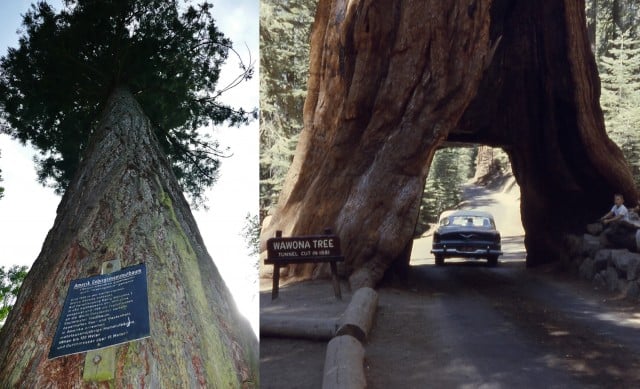 Sequoiadendron (Left) Giganteum planted during the reign of King Wilhelm I. Photo: Wikimedia Commons. The Wawona Tunnel Tree, in Yosemite National Park. Photo: Wikimedia Commons.
Sequoiadendron (Left) Giganteum planted during the reign of King Wilhelm I. Photo: Wikimedia Commons. The Wawona Tunnel Tree, in Yosemite National Park. Photo: Wikimedia Commons.
After becoming obsessed with the giant species of tree when travelling in America, King Wilhelm I had 5,000 Californian mammoth trees planted throughout Germany with a large number of them in and around Stuttgart. The trees are native to the US, where some are estimated to be over 2,000 years old and 100m tall.
Interestingly, the highest concentration of mammoth trees in the city is not in the Botanical-Zoological Gardens or at Schloss Rosenstein, but rather in the Wernhaldenpark in the Weinsteige district. This is because the man responsible for acquiring the seeds was gardener and Stuttgart native, Christian Schickler. Legend has it that he ordered a pound of seeds for the King, not realizing they were as small and light as oats. He ended up having many more seeds than he needed so he planted a few in his garden.
8. The local speciality, Maultasche, have a rather unscrupulous history
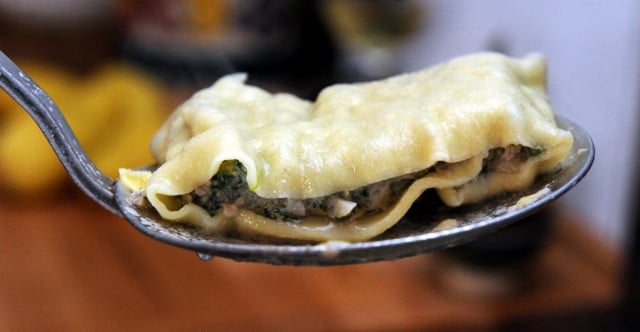 Maultasche with minced meat filling. Photo: DPA.
Maultasche with minced meat filling. Photo: DPA.
Essentially Swabian ravioli from southwestern Germany, Maultaschen are a kind of pasta filled with spinach, sauerkraut, breadcrumbs and sometimes minced meat.
They may seem innocent enough, but their Swabian name 'Herrgottbscheißerle' means 'Lord God Deceivers'. This comes from a legend involving a Cistercian monk from the Maulbronn monastery, 40km north-west of Stuttgart, (hence the name 'Maultasche').
The monk allegedly wanted to eat meat during the Lent fasting period and hid meat in the usually vegetarian filling of his Maultasche in the hope that by sneaking it under a pastry cover, God wouldn't notice.
9. Stuttgart has the second biggest mineral water source in Europe
Stuttgart is home to 14 mineral water springs and several 'Mineralbäde' or spas, mostly concentrated around the Bad Cannstatt area of the city. Because of this, the city provides one of the biggest sources of mineral water in Europe, second only to Budapest's Obuda district.
Stuttgart is sometimes known as the 'Sauerwasserstadt' because of the sulphurous quality of the water. The mineral water is said to have holistic health benefits, allowing locals to save a bit of money at the supermarket as they don't necessarily have to buy expensive bottled water.
10. Cleaning is a public duty in Stuttgart
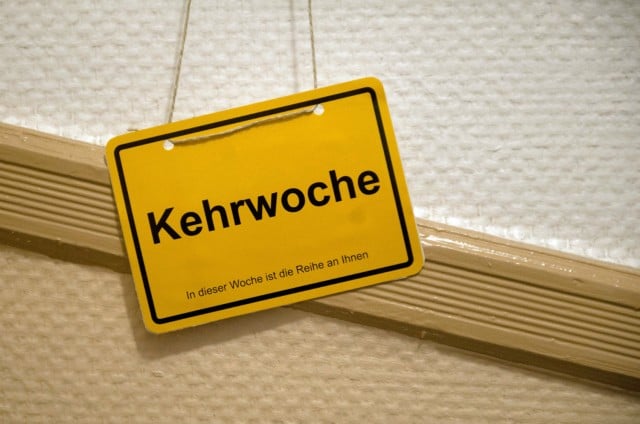 Kehrwoche sign. Photo: DPA
Kehrwoche sign. Photo: DPA
Visitors to the city may notice an unusually high number of people sweeping the pavements. This is because residents of Stuttgart uphold a quirky Swabian tradition known as 'Kehrwoche', which directly translates to 'sweep week'. 'Kehrwoche' is a rotating plan in which a different resident of a rented property is responsible each week for the upkeep of the public areas of a specific building.
This extends from the hallways right out to the steps and pavements in front of the building, so in the autumn and winter months, this means any leaves and snow nearby have to be cleared away too. The common belief is that the practice dates back to several decrees issued in the 16th century, which prompted people to keep the area around their homes clean.
Although this was much more important in the times before indoor plumbing, the tradition is still upheld. Nowadays you won't get in trouble with the law for avoiding your duties during 'Kehrwoche', as there are no written laws, but you may get in trouble with your neighbours.
READ ALSO: German word of the day - Die Kehrwoche
Comments
See Also
1. The city's Fernsehturm was the first of its kind in history
 Stuttgart Fernsehturm. Photo: DPA
Stuttgart Fernsehturm. Photo: DPA
Stuttgart's Fernsehturm, meaning television tower, was the first concrete television tower in the world. Renowned structural engineer and bridge builder Professor Fritz Leonhardt was the mastermind behind the building.
Rather than simply creating a functional metal TV mast, he had the idea to use the tower as a tourist attraction with a restaurant and viewing platform. The tower is 217m tall but stands on a hill making it 283m above sea level in total. It is visible from all over the city and has influenced the design of other television towers around the world.
READ ALSO: Seven maps that explain Baden-Württemberg
2. Stuttgart is the home of the petrol-powered car
 Carl Benz's patented motorvehicle 1885. Photo: DPA
Carl Benz's patented motorvehicle 1885. Photo: DPA
Stuttgart is credited as the birthplace of the petrol powered motorcar with an impressive history in the field of car manufacturing. Pioneering engineers Gottlieb Daimler and Carl Benz were both born near Stuttgart and their 125-year legacy is celebrated at the Mercedes-Benz Welt museum in the east of the city.
Benz is credited with creating the first 3-wheeled, purpose-built motorcar which was up and running in 1886 and 'Benzin', the German word for petrol, is consequently named after him.
Around a similar time, Daimler was working independently on creating a petrol engine which he used to power a modified horse-carriage in 1886. This was the first 4-wheeled motor vehicle in history.
Although the two men never actually met, their companies, Benz & Cie. and Daimler-Motoren-Gesellschaft (DMG), joined forces to create Daimler-Benz AG in the 1920s. From this evolved the brand name Mercedes-Benz and vehicles with the Mercedes and Daimler brand name are still manufactured in the city today.
3. The city gets its name from its horse breeding past
 "Steigendes Pferd" (1939), a statue by Fritz von Graevenitz, in the Höhenpark Killesberg in Stuttgart. Photo: DPA
"Steigendes Pferd" (1939), a statue by Fritz von Graevenitz, in the Höhenpark Killesberg in Stuttgart. Photo: DPA
The area around which the city developed was originally a site for breeding cavalry horses, owned by Duke Liudolf von Schwaben in the 10th century. The name comes from 'Stutengarten' which is an archaic form of the German word 'Gestüt', meaning stud yard.
.jpg) Stuttgart coat of arms. Photo: Wikipedia. Porsche badge. Photo: Pixabay.
Stuttgart coat of arms. Photo: Wikipedia. Porsche badge. Photo: Pixabay.
The city coat of arms is consequently a black stallion which is recognizable to people around the world as it is featured on the Porsche logo, a make of cars which also originates from the Stuttgart area.
4. It is the only German city with a municipal wine estate
 The vineyard of the IHK Stuttgart. Photo: DPA
The vineyard of the IHK Stuttgart. Photo: DPA
The presence of the wine industry in Stuttgart is hard to miss, with vineyards throughout the very heart of the city. Surprisingly, one of these vineyards is owned by a governmental department.
The Industrie- und Handelskammer Stuttgart (IHK), meaning Chamber of Industry and Commerce, came into possession of a vineyard and villa just before the outbreak of the Second World War. The plan was to use the plot of land to build a new IHK house with space for administration, events and the Stuttgart stock and securities exchange.
These plans were never fully realised due to the turmoil of the war; much of the land remained a vineyard which is still owned by the IHK to this day.
The Romans originally brought grape vines from the Tyrol region to Stuttgart in 3AD and grapes continue to thrive around the city creating popular wines such as Riesling and Trollinger.
5. Stuttgart is a city of stairs
 Stairway in the city centre. Photo: DPA
Stairway in the city centre. Photo: DPA
The capital of Baden-Württemberg is built upon a large number of hills, but with this comes the potentially more enjoyable side effect of a large number of vineyards.
To help people get up and down these hills each day, Stuttgart has over 400 sets of outdoor stairs in total. If you climbed them all, you would climb about 20 kilometres in total.
6. It's the number one city for culture in Germany, according to one study
 Stuttgart opera house. Photo: DPA
Stuttgart opera house. Photo: DPA
Stuttgart was ranked as the best city for culture in the country in a study by the Berenberg Bank and the Hamburgischen Weltwirtschaftsinstituts (HWWI) back in 2016.
In the city, 7.6 percent of people eligible to pay social insurance are employed in the culture sector - the highest proportion in Germany.
The number of people who visit museums, shows, concerts and other cultural events is also the highest of any city in the country, according to the study. This is visible throughout the year with more than 190 dance, music, literature, art, food, and cultural festivals taking place in Stuttgart (in non-Covid times).
7. Stuttgart has unique mammoth trees which are native to the US
 Sequoiadendron (Left) Giganteum planted during the reign of King Wilhelm I. Photo: Wikimedia Commons. The Wawona Tunnel Tree, in Yosemite National Park. Photo: Wikimedia Commons.
Sequoiadendron (Left) Giganteum planted during the reign of King Wilhelm I. Photo: Wikimedia Commons. The Wawona Tunnel Tree, in Yosemite National Park. Photo: Wikimedia Commons.
After becoming obsessed with the giant species of tree when travelling in America, King Wilhelm I had 5,000 Californian mammoth trees planted throughout Germany with a large number of them in and around Stuttgart. The trees are native to the US, where some are estimated to be over 2,000 years old and 100m tall.
Interestingly, the highest concentration of mammoth trees in the city is not in the Botanical-Zoological Gardens or at Schloss Rosenstein, but rather in the Wernhaldenpark in the Weinsteige district. This is because the man responsible for acquiring the seeds was gardener and Stuttgart native, Christian Schickler. Legend has it that he ordered a pound of seeds for the King, not realizing they were as small and light as oats. He ended up having many more seeds than he needed so he planted a few in his garden.
8. The local speciality, Maultasche, have a rather unscrupulous history
 Maultasche with minced meat filling. Photo: DPA.
Maultasche with minced meat filling. Photo: DPA.
Essentially Swabian ravioli from southwestern Germany, Maultaschen are a kind of pasta filled with spinach, sauerkraut, breadcrumbs and sometimes minced meat.
They may seem innocent enough, but their Swabian name 'Herrgottbscheißerle' means 'Lord God Deceivers'. This comes from a legend involving a Cistercian monk from the Maulbronn monastery, 40km north-west of Stuttgart, (hence the name 'Maultasche').
The monk allegedly wanted to eat meat during the Lent fasting period and hid meat in the usually vegetarian filling of his Maultasche in the hope that by sneaking it under a pastry cover, God wouldn't notice.
9. Stuttgart has the second biggest mineral water source in Europe
Stuttgart is home to 14 mineral water springs and several 'Mineralbäde' or spas, mostly concentrated around the Bad Cannstatt area of the city. Because of this, the city provides one of the biggest sources of mineral water in Europe, second only to Budapest's Obuda district.
Stuttgart is sometimes known as the 'Sauerwasserstadt' because of the sulphurous quality of the water. The mineral water is said to have holistic health benefits, allowing locals to save a bit of money at the supermarket as they don't necessarily have to buy expensive bottled water.
10. Cleaning is a public duty in Stuttgart
 Kehrwoche sign. Photo: DPA
Kehrwoche sign. Photo: DPA
Visitors to the city may notice an unusually high number of people sweeping the pavements. This is because residents of Stuttgart uphold a quirky Swabian tradition known as 'Kehrwoche', which directly translates to 'sweep week'. 'Kehrwoche' is a rotating plan in which a different resident of a rented property is responsible each week for the upkeep of the public areas of a specific building.
This extends from the hallways right out to the steps and pavements in front of the building, so in the autumn and winter months, this means any leaves and snow nearby have to be cleared away too. The common belief is that the practice dates back to several decrees issued in the 16th century, which prompted people to keep the area around their homes clean.
Although this was much more important in the times before indoor plumbing, the tradition is still upheld. Nowadays you won't get in trouble with the law for avoiding your duties during 'Kehrwoche', as there are no written laws, but you may get in trouble with your neighbours.
READ ALSO: German word of the day - Die Kehrwoche
Join the conversation in our comments section below. Share your own views and experience and if you have a question or suggestion for our journalists then email us at [email protected].
Please keep comments civil, constructive and on topic – and make sure to read our terms of use before getting involved.
Please log in here to leave a comment.